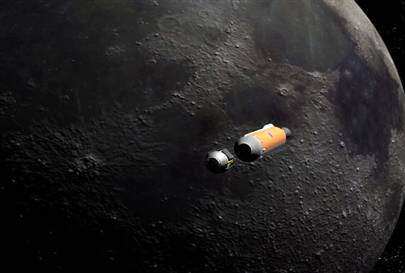The Lunar Crater Observation and Sensing Satellite (LCROSS) is a very exciting mission for lunar exploration. Since the discovery of water on Mars by Phoenix last week, focus is turning on other planetary bodies and natural satellites for the possibility they may hold a supply of water too. First stop for any manned mission will be our return trip to the Moon by 2020, so it would be very advantageous if we could find a frozen reservoir of H2O hiding within the craters of the lunar surface. LCROSS is going to hitch a ride with the Lunar Reconnaissance Orbiter (LRO) later this year on board an Atlas V rocket. It has just passed some gruelling pre-launch tests before it sets out on a suicide mission that will end in collision with the lunar surface…
To make sure LCROSS can stand up to the huge temperature gradients it will experience during its lunar adventure, engineers have subjected it to rigorous heating and cooling cycles at the Northrop Grumman facility in Redondo Beach, California. These tests come after successful completion of thermal vacuum testing at the start of this month. LCROSS has also been given the thumbs up after passing a launch acoustic vibration simulation intended to see how the integrity of the spacecraft copes with the violence of an Atlas V blast-off.
This new round of tests heated the spacecraft to 230°F (110°C) and then cooled it to -40°F (-40°C) over 13.5 days to simulate the extremes of temperature it will experience en-route to the Moon and flyby.
“The spacecraft steadily has taken shape since Ames delivered the science payload in January. It is a testament to the hard work, perseverance and expertise of the NASA and Northrop Grumman teams that the spacecraft has completed these critical tests ahead of schedule.” – Daniel Andrews, LCROSS project manager, NASA’s Ames Research Center, California.
When in orbit around the Moon in 2009, LCROSS will create two impact plumes in the lunar surface. The target will be a crater near the lunar polar region that is constantly in shadow. This is the perfect location for water ice to form, if there’s any at all.
The Atlas V’s Centaur upper stage rocket will carry LCROSS to the Moon and execute a lunar flyby. It will then enter an elongated Earth orbit, putting the probe in the correct trajectory, ready for LCROSS-Centaur separation. The Centaur stage will then be instructed to carry out a suicidal plunge into the surface so the resulting plume of dust and gas that will rise into the orbital path for LCROSS to analyse. Once data about the plume is relayed to Earth, LCROSS itself will make the ultimate sacrifice, ploughing into the Moon’s surface, creating a second plume of debris for Earth-based observatories to analyse.
It is hoped this trailblazer mission will unlock some of the lunar secrets as to whether water ice is present in any great quantities inside this polar crater, possibly the source for a future manned lunar base.


Hi R2K, I’m not too sure how they are going to deal with that – I can only assume they will fill the tank with just enough fuel until it runs out and let the fly-by do the rest. I’m sure that they will cater for any contaminants from the vehicle…
Cheers, Ian
Odd… The Centaur upper stage uses H2 + O2, no? Isnt it possible that some residue (say several KG of each) could ruin the experiment?
Love the article. Thanx
If water turns out to be scarce on the moon, will we end up regretting vaporizing some of it?
Nexus said “If water turns out to be scarce on the moon, will we end up regretting vaporizing some of it?”
No worry, we then refill that reservoir by bombarding it with rockets containing water ice.
How odd that “scientific exploration” seems to have been reduced (in this case) to the equivalent
of taking a hammer to something to see what’s inside. First a comet and now our Moon. Has to be a better way than inflicting all these human-made craters on the old girl.
A suicide mission? Or one that does not leave junk in orbit for years and years and years.
Vanamonde, you’re right! Instead, it litters the moon! Just as good.
According to lunar.gsfc.nasa.gov/mission.html the “Lunar Reconnaissance Orbiter” itself carries
(a) the Diviner Lunar Radiometer Experiment (DLRE): “giving detailed information about surface and subsurface temperatures (identifying … potential ice deposits”
(b) the Lyman Alpha Mapping Project (LAMP): “search for surface ice and frost in the polar regions”
(c) the Lunar Exploration Neutron Detector (LEND): “can be used to search for evidence of water ice on the Moon’s surface”
(d) the Mini-RF technology demonstration: “to search for subsurface water ice deposits”
In Astronomy Cast “Missions to Mars, Part 2” at timestamp 00:07:45, Fraser and Pamela start talking about the finding of water everywhere on Mars from orbit with a gamma ray spectrometer (GRS) onboard of the “Mars Odyssey”.
These instruments are maybe capable to find ice by nondestructive methods.
Rellis: “How odd that “scientific exploration” seems to have been reduced (in this case) to the equivalent
of taking a hammer to something to see what’s inside. First a comet and now our Moon. Has to be a better way than inflicting all these human-made craters on the old girl.”
…. How do you think exploration and mining works on Earth? All the metal around you that you use everyday came from mines that were likely discovered by some prospector hammering on some rock somewhere.
The moon is a big place. It can take it.
If you ever want to hear a reader’s feedback 🙂 , I rate this post for 4/5. Detailed info, but I have to go to that damn yahoo to find the missed pieces. Thank you, anyway!